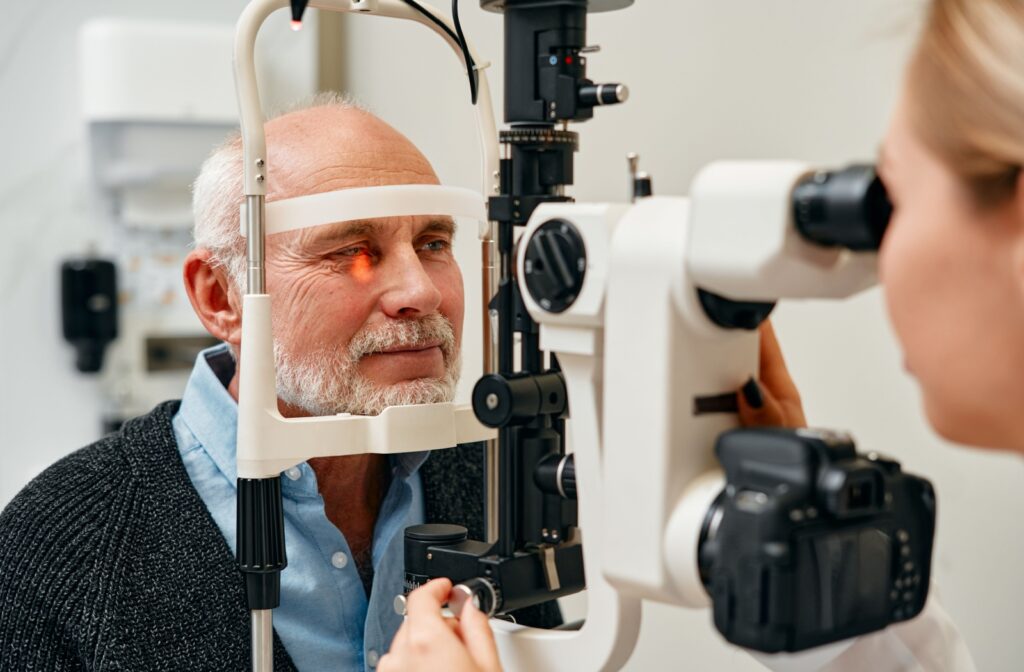Your eyes do much more than help you see. They can offer a glimpse into your overall health and show signs of all kinds of different eye conditions and systemic diseases. Routine eye exams aren’t just about updating glasses—they are primarily about detecting early signs of serious conditions that could affect your overall health.
During a comprehensive eye exam, your optometrist can detect diseases such as:
- Refractive errors
- Cataracts
- Glaucoma
- Age-related macular degeneration
- Diabetic retinopathy
- High blood pressure
- Other systemic conditions
Refractive Errors
The most common conditions detected during an eye exam are refractive errors. These aren’t technically diseases—they’re abnormalities that tend to begin during childhood years. Refractive errors are the result of the size and shape of your eye which cause vision issues at different distances.
There are 4 refractive errors:
- Myopia, or nearsightedness, where near vision is clear but far vision is blurry
- Hyperopia, or farsightedness, where near vision is blurry and far vision is clear
- Astigmatism, a condition of the cornea and lens that affects vision at all distances
- Presbyopia, a condition that develops around middle age and affects your near vision
During an eye exam, you’ll undergo plenty of different tests for your vision to determine whether corrective measures like glasses or contacts are needed.
Cataracts
Cataracts occur when the natural lens of the eye becomes cloudy. This is often a normal part of the aging process, but can occur for many reasons. Cataracts can make it harder to drive at night, read small print, or see objects clearly—even during the day.
Cataracts often develop slowly, so you may not notice symptoms at first. They may cause:
- Blurry or dim vision
- Difficulty with night vision
- Halos around lights
- Sensitivity to bright light
Routine Eye exams allow your optometrist to identify cataracts in the early stages—often before symptoms cause vision changes. Early detection makes cataracts much easier to manage and allows for planning for solutions when they become problematic.
Glaucoma
Glaucoma, known as “the silent thief of sight,” often occurs without noticeable symptoms in the early phases. It develops when fluid pressure within the eye becomes too high which slowly and painlessly damages the optic nerve leading to blindness if untreated.
There are several types of glaucoma, each with its own unique cause and treatment. The common types of glaucoma include:
- Open-angle glaucoma
- Angle-closure glaucoma
- Normal-tension glaucoma
- Secondary glaucoma
Routine Eye exams are the only way to detect glaucoma early. Your optometrist measures the intraocular pressure or IOP with a device called a tonometer.
Tonometry is the test to measure your eye pressure, which is not directly related to your blood pressure.. Early diagnosis makes it significantly easier to treat glaucoma to slow down progression and prevent future vision loss.
Age-Related Macular Degeneration
The macula, the part of the retina responsible for sharp central vision and colour vision, may be at risk for deterioration with age in some people. This condition, called age-related macular degeneration (AMD), is a leading cause of vision loss in adults over 50. It affects your ability to see fine details in your central vision.
Some symptoms of AMD include:
- Dark areas in the center of vision
- Distorted vision, such as straight lines appearing wavy
- Reduced color vibrancy
Routine eye exams are the only way to detect the earliest signs of AMD so protective interventions can be initiated. Your optometrist uses sophisticated retinal imaging technology to discover abnormal deposits and changes to the retina. While there is no cure for AMD, it can be effectively managed to slow down progression and protect your remaining vision.
Diabetic Retinopathy
For those living with diabetes, eye health is closely tied to blood sugar control. Diabetic retinopathy occurs when high blood sugar levels damage the tiny blood vessels within the retina. This can lead to permanent vision loss if left untreated.
The symptoms of diabetic retinopathy include:
- Blurry vision
- Dark spots or floaters in your field of vision
- Poor night vision
- Sudden vision changes
Coming in for an eye exam allows detection of early signs of diabetic retinopathy, before it becomes vision threatening. Your optometrist looks for swelling or leaking of the retinal blood vessels. They’ll also give you advice on effectively managing your condition to reduce your risk of permanent vision damage.
High Blood Pressure
High blood pressure, or hypertension, doesn’t just affect your heart. It can also have a significant impact on your eye health. High blood pressure can damage the blood vessels in the retina. Over time, this can increase the risk of more severe eye issues. Additionally, untreated or poorly controlled high blood pressure can cause a sudden “stroke” in the eye resulting in permanent vision loss.
The symptoms of hypertension-related eye damage may include:
- Reduced or blurry vision
- Swelling in the eye
- Double vision or sudden vision changes
- Headaches paired with vision issues
This isn’t always noticeable in the early stages. It’s just one more reason why preventative regular eye exams are so valuable. During the eye exam, your optometrist can detect the early signs of eye and retinal damage and diagnose your condition. Then, they can work with you to reduce the risk of permanent damage.
How Often Should You Book an Eye Exam?
Regular eye exams are vital for maintaining both vision and eye health. They’re the key to detecting conditions like cataracts, glaucoma, and more. You should visit your optometrist at least once a year so they can monitor any changes in your eyes. And here at Whitby Family Eye Care, we’re ready to help. Book your appointment with us today, and let’s work together to keep your eyes healthy and your vision clear.







